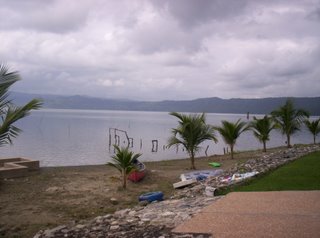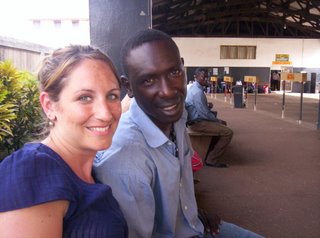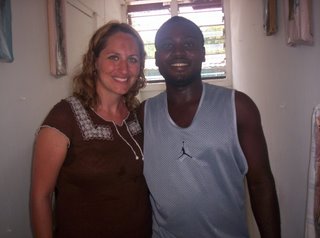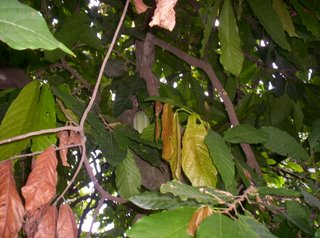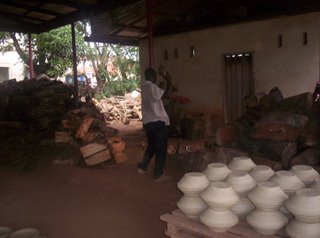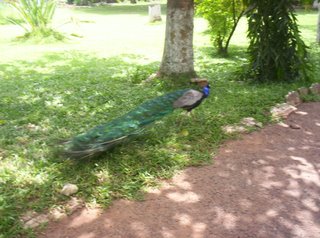Lucy, Francis, Francis, and DJ Wayas in Elmina and Cape Coast
I will start with my gratitude towards Lucy and Francis. They live and run the Java House/Museum. They have been welcoming and gracious throughout my stay. I couldn't imagine Elmina without them.
Francis is the teacher I gave the money that my students raised to. He will use it in his classroom (to prevent any possible corruption in the use of the funds). I took pictures of the students and their classroom. I visited during a math lesson (long division). Imagine teaching 48 sixth grade students long division. Some of the kids got it, some didn't and it would be difficult to manage getting to all of them. I work with the group that was around me, they were so eager to learn. I am sure he will put the money to good use. Some of the kids have made and brought things to the Java House for me to give my students. I am excited to bring them back and share.
I went to church with Francis (Lucy teaches the children at Sunday School) on Sunday. He attends a Charasmatic Church. And it was. There was singing, dancing, and clapping. It lasted over three hours. The small children continued to come up to the Broni (me) throughout the service, and often when I looked, they ran away. I did make one friend, she was around 1-2 years old and she came up and hugged my leg for quite some time. She stole my heart, it's true. After church, Francis and I discussed religion, salvation and our own testimonies. He is an amazing person who has come so far. He is a pillar in this community. I feel lucky to have met him.
Francis, from the internet cafe, is another new found friend. Most of the time when I leave the internet cafe, it is dark. Now, a Broni has a special price for a shared taxi (this can range from $ .10 to $6.00 more than a local) but then you add in the nighttime-Broni price and its straight extortion. Well, Francis has helped me with this problem. He doesn't understand the discrepancy, when I mentioned its because I am white, he was disappointed. So, he not only walked me to the taxi station, but found the taxi going to Elmina and paid for my ride. By the third night, I was able to complete this task on my own without complications. But, had Francis not been there, I would be paying the high prices and then ridiculed for being Broni. Francis also, introduced me to an American student named Habib from Denver who is here learning to drum. Last night we had Kraft Mac n Cheese for dinner. Francis didn't like it and tried to stuff it down his throat, but it was, to say the least difficult. But, what a good sport.
DJ Wayas, birth name Richmond, is a local radio dj/festival promoter/youth advocate/community supporter and tour guide. He wants to marry a white girl and thinks Hassan should hurry up and marry me so that we can have kids calling me "mommy." I mentioned that I am entering a doctoral program and that right now might not be the right time for kids and he explained it would not be that hard. Right. So we disagreed. But he did tell me that there was a drumming ritual going on in the evening and agreed to meet me at the Methodist church later and take me there. Everyone, including the king and the tortise shell attended. There was drumming and singing (evidently drums have not been played in Elmina, waiting for this festival for weeks). The high priests sat (in the rain) on one side of the courtyard, the King sat with the shell in front of him protected from the rain under an overhang, the priestesses (elderly women wearing white) sat opposite of the King and every once in a while, they would get up and dance around to the beat of the drum. There is a room behind the King and that is where the ghosts are located during the ceremony. It started at 8pm and when I got there, DJ Wayas and I were walking, then he was pulled on stage. The kids went wild, evidently he is somewhat of a celebrity. After his "performance", we went to the ritual area. This ritual lasts all night (until dawn) and it was raining. Guess what, there are no umbrellas allowed, everytime someone opened one, they would be asked to close it. This included the cheifs. We watched for a while, then an elderly man came up to me, the token Broni, and we talked, then I bought him ice cream. After this we left the ritual and went to the Shell Station (yes, Shell gas). Here they had a DJ, hip hop, reggae, hip life music and dancing. I drank a Star beer and danced with a few locals (Funny Boy and his crew- www.asantidancegroup.com). Richmond took very good care of me and then got a taxi to get me home. Oh what a night!
Francis is the teacher I gave the money that my students raised to. He will use it in his classroom (to prevent any possible corruption in the use of the funds). I took pictures of the students and their classroom. I visited during a math lesson (long division). Imagine teaching 48 sixth grade students long division. Some of the kids got it, some didn't and it would be difficult to manage getting to all of them. I work with the group that was around me, they were so eager to learn. I am sure he will put the money to good use. Some of the kids have made and brought things to the Java House for me to give my students. I am excited to bring them back and share.
I went to church with Francis (Lucy teaches the children at Sunday School) on Sunday. He attends a Charasmatic Church. And it was. There was singing, dancing, and clapping. It lasted over three hours. The small children continued to come up to the Broni (me) throughout the service, and often when I looked, they ran away. I did make one friend, she was around 1-2 years old and she came up and hugged my leg for quite some time. She stole my heart, it's true. After church, Francis and I discussed religion, salvation and our own testimonies. He is an amazing person who has come so far. He is a pillar in this community. I feel lucky to have met him.
Francis, from the internet cafe, is another new found friend. Most of the time when I leave the internet cafe, it is dark. Now, a Broni has a special price for a shared taxi (this can range from $ .10 to $6.00 more than a local) but then you add in the nighttime-Broni price and its straight extortion. Well, Francis has helped me with this problem. He doesn't understand the discrepancy, when I mentioned its because I am white, he was disappointed. So, he not only walked me to the taxi station, but found the taxi going to Elmina and paid for my ride. By the third night, I was able to complete this task on my own without complications. But, had Francis not been there, I would be paying the high prices and then ridiculed for being Broni. Francis also, introduced me to an American student named Habib from Denver who is here learning to drum. Last night we had Kraft Mac n Cheese for dinner. Francis didn't like it and tried to stuff it down his throat, but it was, to say the least difficult. But, what a good sport.
DJ Wayas, birth name Richmond, is a local radio dj/festival promoter/youth advocate/community supporter and tour guide. He wants to marry a white girl and thinks Hassan should hurry up and marry me so that we can have kids calling me "mommy." I mentioned that I am entering a doctoral program and that right now might not be the right time for kids and he explained it would not be that hard. Right. So we disagreed. But he did tell me that there was a drumming ritual going on in the evening and agreed to meet me at the Methodist church later and take me there. Everyone, including the king and the tortise shell attended. There was drumming and singing (evidently drums have not been played in Elmina, waiting for this festival for weeks). The high priests sat (in the rain) on one side of the courtyard, the King sat with the shell in front of him protected from the rain under an overhang, the priestesses (elderly women wearing white) sat opposite of the King and every once in a while, they would get up and dance around to the beat of the drum. There is a room behind the King and that is where the ghosts are located during the ceremony. It started at 8pm and when I got there, DJ Wayas and I were walking, then he was pulled on stage. The kids went wild, evidently he is somewhat of a celebrity. After his "performance", we went to the ritual area. This ritual lasts all night (until dawn) and it was raining. Guess what, there are no umbrellas allowed, everytime someone opened one, they would be asked to close it. This included the cheifs. We watched for a while, then an elderly man came up to me, the token Broni, and we talked, then I bought him ice cream. After this we left the ritual and went to the Shell Station (yes, Shell gas). Here they had a DJ, hip hop, reggae, hip life music and dancing. I drank a Star beer and danced with a few locals (Funny Boy and his crew- www.asantidancegroup.com). Richmond took very good care of me and then got a taxi to get me home. Oh what a night!
